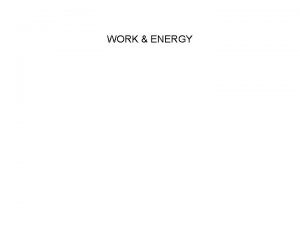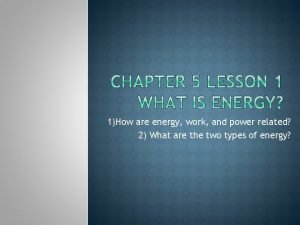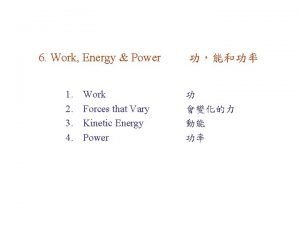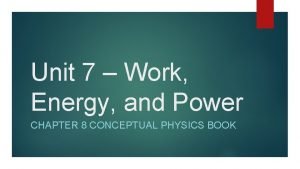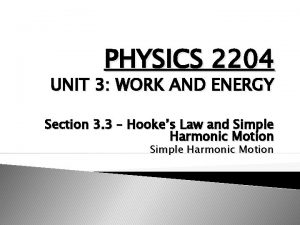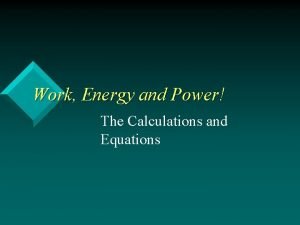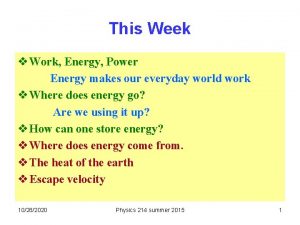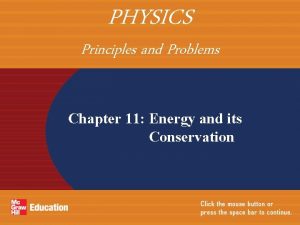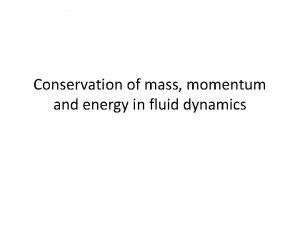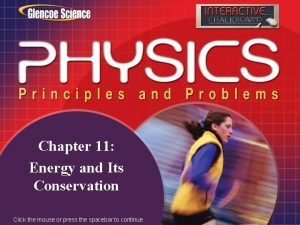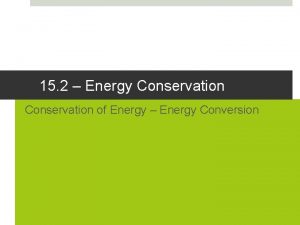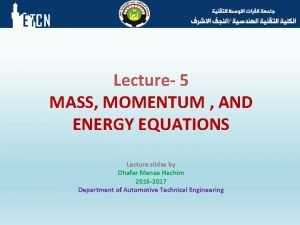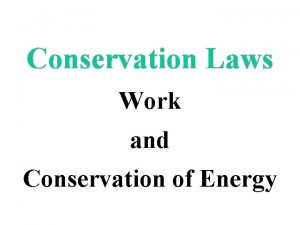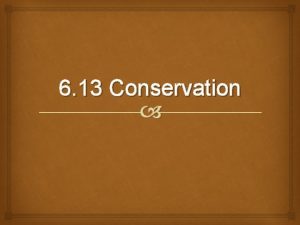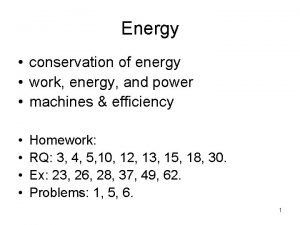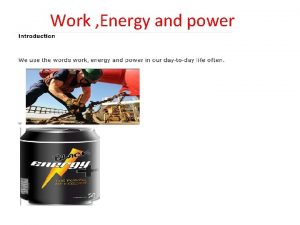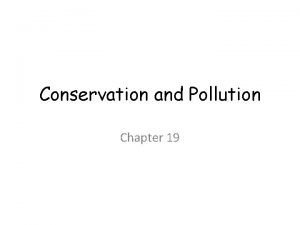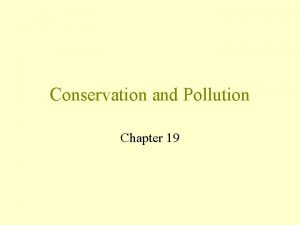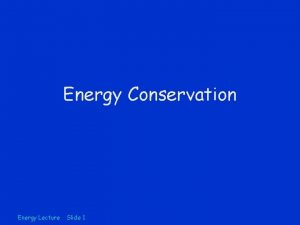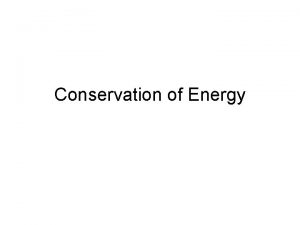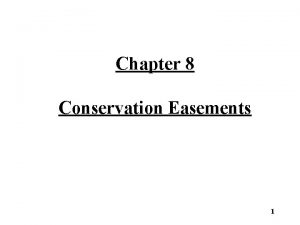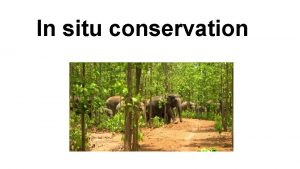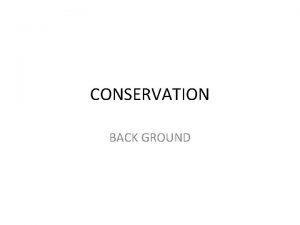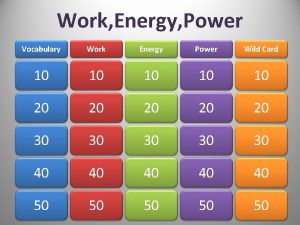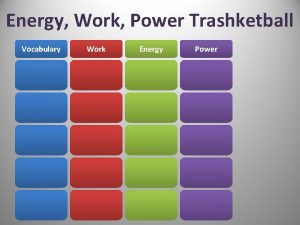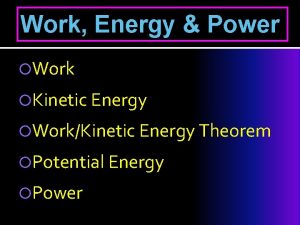Energy conservation of energy work energy and power




















- Slides: 20

Energy • conservation of energy • work, energy, and power • machines & efficiency • • Homework: RQ: 3, 4, 5, 10, 12, 13, 15, 18, 30. Ex: 23, 26, 28, 37, 49, 62. Problems: 1, 5, 6. 1

Energy & Work • Energy is the capacity to do ______ • Unit: joule = newton·meter (J = N·m) • Work = force x distance (Fd) when force is in direction of motion (or opposite to motion) • Ex. 50 N pushes distance of 4 meters. • W = (50 N)(4 m) = ________ • / 2

Machines • change an applied force by ______ it, _____________ it, or ___________ its direction. • • Types: inclined plane, screw, wedge pulley, wheel lever 3

levers • Work input Fd = Work output Fd F __ F = d __ d • Ex. Your hand moves 100 m, causes car to rise 0. 10 m. The force amplification factor is,

inclined plane • Weight x height change • = Force x distance along plane • Force along ramp _____ than Weight • Ramp distance ______ than height change • ADA Standards: Ramp must be at least 12 x longer than vertical rise • Ex. A 1 ft vertical rise requires ______ of ramp. 5

Machine Efficiency • • • = (work output)/(energy input) x 100% Ex: 10 J are input and 9 J are output. Efficiency = (9)/(10) x 100% = _______ Ex: 5 J are input and 4 J are output. Efficiency = (4)/(5) x 100% = ____ • / 6

Energy of Motion • • Called Kinetic Energy (KE) KE = ½(mass)(velocity)2 = ½mv 2. Ex. 2000 kg car moving at 2 m/s. KE = ½ (2000)(2)2 = ______ 7

Work & Energy • Work transforms energy from one ______ to another • Work = DKE • Ex. Calculate distance 100 N must act to move a 2000 kg car from rest to 2 m/s: • Work = Fd = (100 N)(d) = 4000 J • d = 4000 J/100 N = _______ • // 8

Power • Power is the ____ work is performed • Power = work/time = _________ • Unit: watt = joule/second = J/s • Other Unit: horsepower • 1 horsepower = 746 watts • / 9

Energy & Power • Energy = power x time • Ex. A toy car has 1000 J of energy at full charge. • How long can it run at 100 watts? At 10 watts? • Time = Energy/power • = 1000 J/100 watts = 10 seconds • = 1000 J/10 watts = 100 seconds/ 10

Energy & Efficiency • 1 gallon gasoline has ________ • Engines only get a fraction of this: • Ex. A 25% efficient car gets (0. 25)(138, 000 J) = 34, 500, 000 J out of 1 gallon. • A 20% efficient car gets 27, 600, 000 J. 11

Mpg (20% Efficient Engine) • Work = Force x distance • Ex. 400 N for 1600 meters (1 mile) • Work = (400 N)(1600 m) = 640, 000 J for one mile traveled (1 mile/640, 000 J) • Engine gets 27, 600, 000 J per gallon • (at constant speed) 12

Stop & Go Mpg • Energy is used to speed car, and all is _____ to _____ when stopping • Mpg much less in stop & go conditions • / 13

Size, Shape & Mpg • Block shape creates _____ air friction than rounded shape car • Larger vehicles experience ____ air friction • Air friction = Shape factor x Frontal Size • Ex. At 60 mph, an SUV can experience about 4 x more air drag than a small car. • / 14

Speed & Mpg • For a given vehicle, air friction increases with the ______ • Ex. If you double your speed, the air friction will increase by a factor of 4. • / 15

Potential Energy • … is energy due to _________ • Ex. Book standing on one end has more potential energy than when lying flat • Ex. A ball 1 m above floor has more potential energy than when on the floor. 16

Gravitational Potential Energy • • • = mass x gravity x height Ex. A 2 kg ball is 1 m above the floor Grav. Pot. Energy = (2 kg)(10 N/kg)(1 m) = 20 joules Ex. A 10 kg sack of rice 0. 5 m above the floor has Grav. Pot. Energy • = (10 kg)(10 N/kg)(0. 5 m) • = 50 joules 17

Conservation of Energy • Energy cannot be created or destroyed; but is _________ from one form into another – the total amount staying the same. • Ex. A falling object _______ Gravitational Energy as it falls, but ______ an equal amount of Kinetic Energy. • / 18

Mechanical Energy • = sum of __________ Energy • Ex. A glider slides down an inclined air track. The Mech. Energy = KE + mgh = constant as the glider moves to lower heights h. • / 19

Summary • work = Fd (F along d) • work = 0 (F perpendicular to d) • Power = work/time = Fv • KE = ½mv 2. GPE = mgh • work = change in KE • total energy always conserved • machines & efficiency 20
 Chapter 4 section 1 work and machines answer key
Chapter 4 section 1 work and machines answer key Draw the power triangle
Draw the power triangle Chapter 7 energy conservation of energy
Chapter 7 energy conservation of energy Work, power and energy activities
Work, power and energy activities Define energy work and power
Define energy work and power How are energy work and power related
How are energy work and power related Work power energy and machines
Work power energy and machines W=fdcosθ meaning
W=fdcosθ meaning Work power and energy
Work power and energy Jenis usaha apa
Jenis usaha apa Physics 03-02 potential energy and conservative forces
Physics 03-02 potential energy and conservative forces Regents physics work power energy
Regents physics work power energy Unit of resistivity
Unit of resistivity Physics 2204 unit 3: work, power, energy
Physics 2204 unit 3: work, power, energy Work energy power equations
Work energy power equations Work energy power
Work energy power Chapter 11 physics study guide
Chapter 11 physics study guide Ideal fluid
Ideal fluid Chapter 11 energy and its conservation answers
Chapter 11 energy and its conservation answers Energy conversion and conservation
Energy conversion and conservation Conservation of mass momentum and energy equations
Conservation of mass momentum and energy equations



